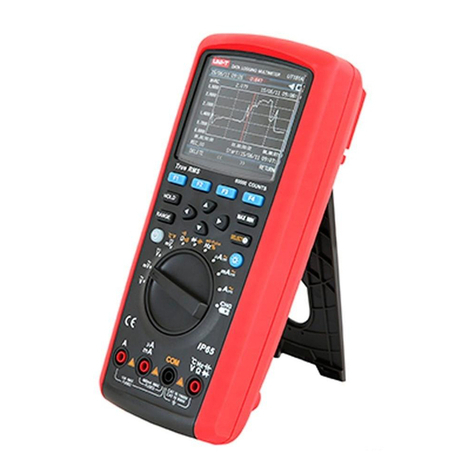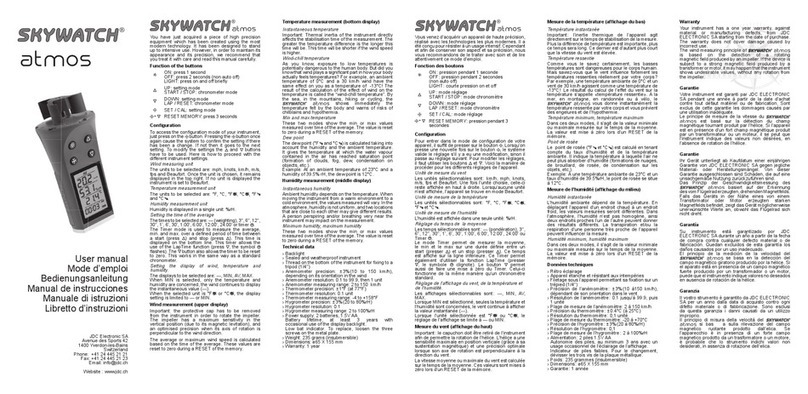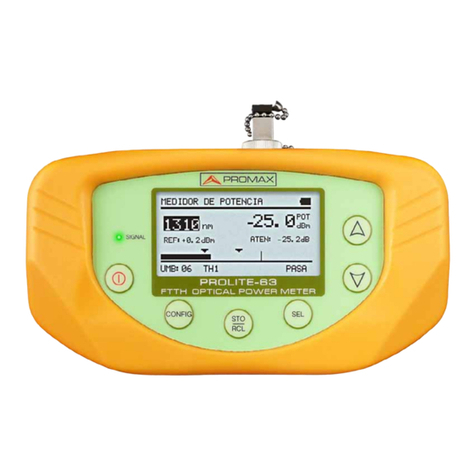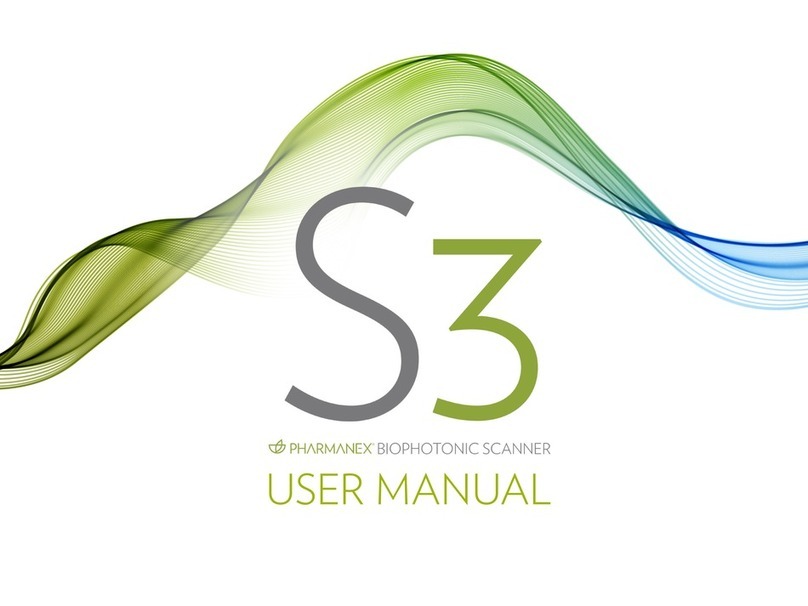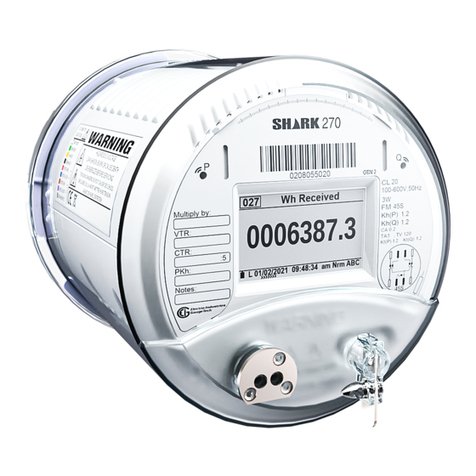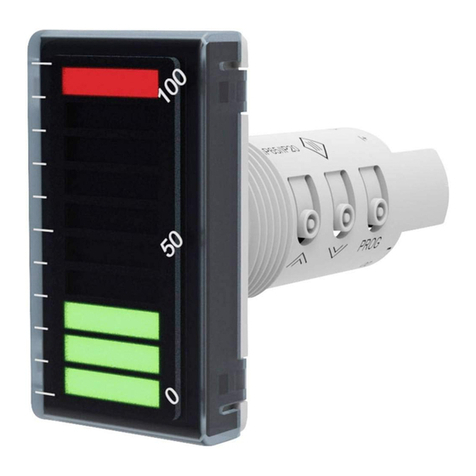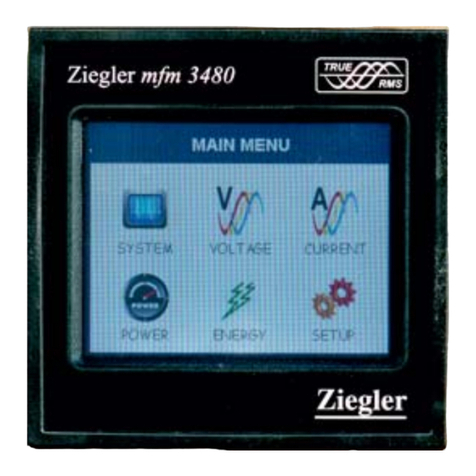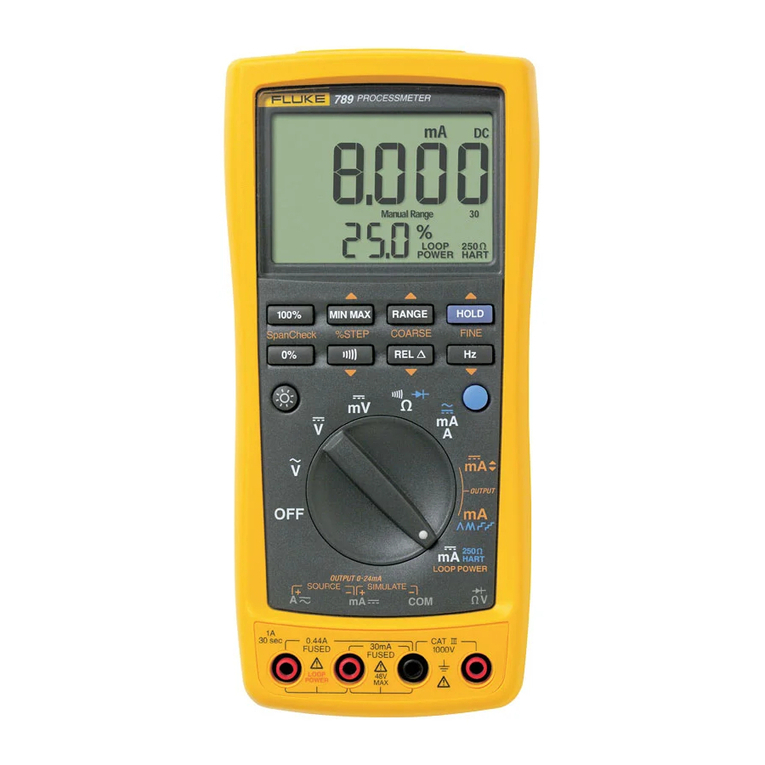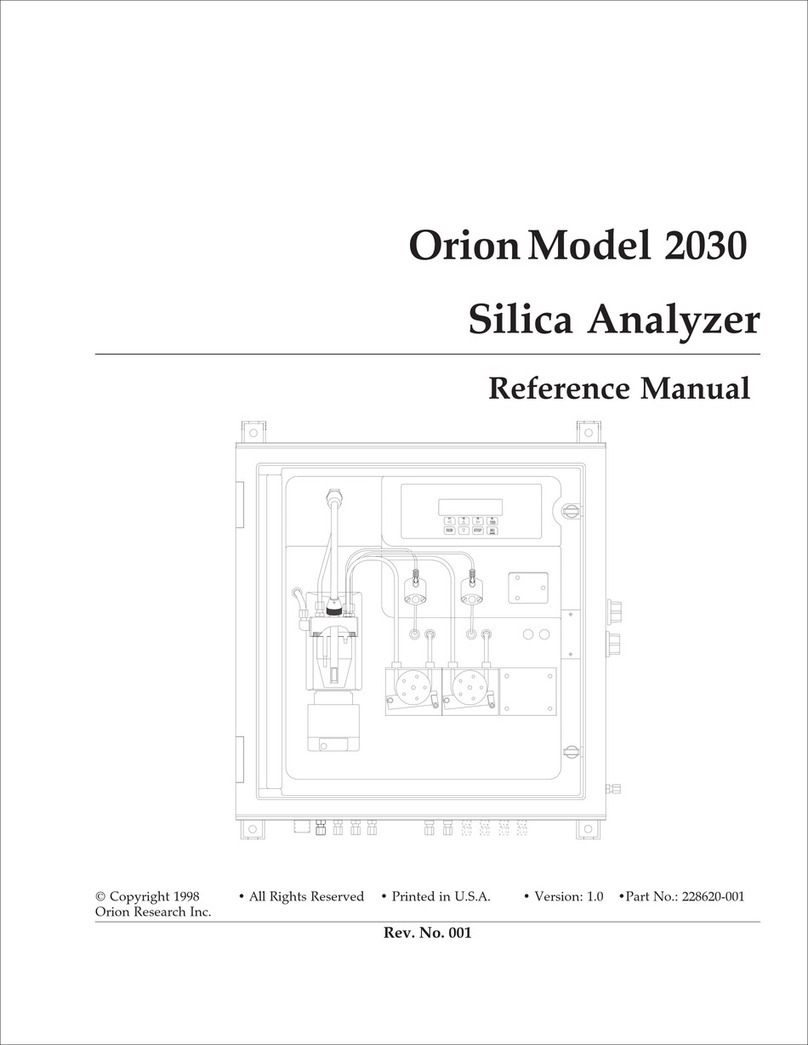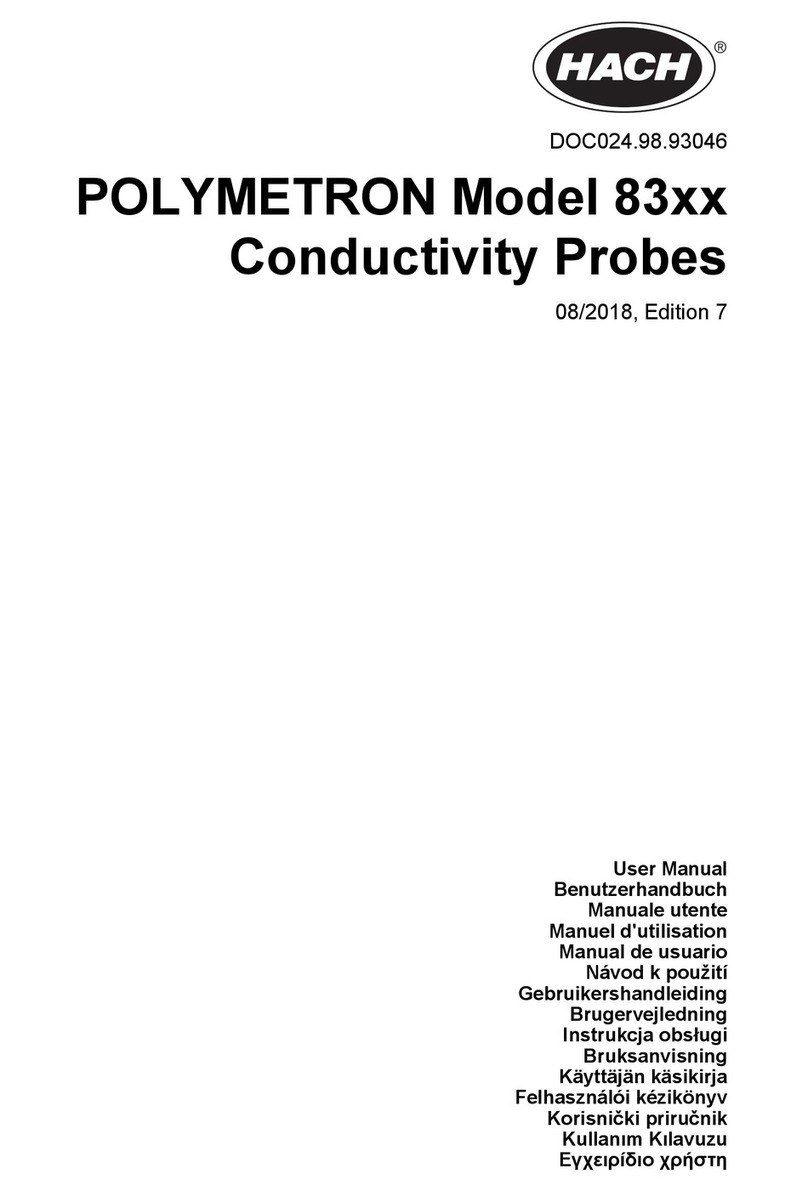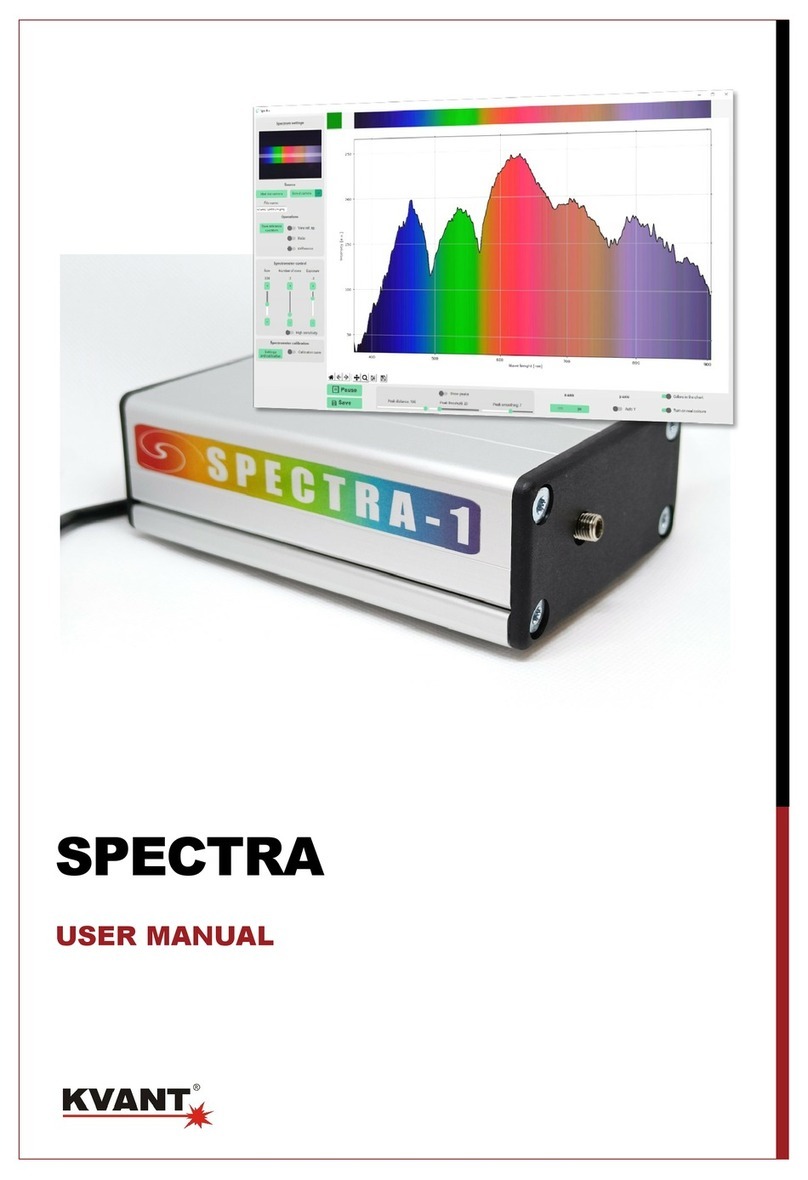Teilch TCH Pro 202 User manual

Operation Manual TCH Pro 202 & 203
Handheld Particle Analyzer
Models TCH Pro 202
& TCH Pro 203
Page of1 33
TCH Pro v1.2.1

Operation Manual TCH Pro 202 & 203
Safety Information
This section gives instructions for promoting safe and proper handling of the Particle
Analyzer.
Laser Safety
The Model TCH Pro 20x handheld Particle Analyzer is a Class I laser-based instrument.
•During normal operation, you will not be exposed to laser radiation.
•WARNING: Class IV visible or invisible laser inside. Exposure to this light causes
blindness.
•DO NOT remove any cover or disassemble the device.
Important - Take these precautions
•DO NOT remove any parts from the particle analyzer unless you are specifically told to do
so in this manual.
•DO NOT remove the housing or covers. There are no user serviceable components inside
the housing. All repair and maintenance needs should be done by a qualified technician.
•Take precautions not to get any particles over 50 μm inside the unit. Failure due to
foreign objects found in the unit are not covered by the Warranty.
•Precautions for power use:
•AC Adaptor. The AC adapter accommodates voltage of AC 100~240V and frequency of
50/60 Hz.
•Batteries: 2 units of Li-ion, 3.7V, size 18650.
Page of2 33
TCH Pro v1.2.1

Operation Manual TCH Pro 202 & 203
Table of Contents
CHAPTER 1: PRODUCT OVERVIEW
Introducing TCH PRO MODELS"4
Specifications"6
CHAPTER 2: UNPACKING
Box Content"7
CHAPTER 3: THEORY OF OPERATION
II. Particle Detection"8
III. Calibration"11
CHAPTER 4: OPERATION
I. Getting Started"15
II. Screen Symbols"16
III. Menu Map"17
IV. Functionalities"18
V. Data Management"2 8
VI. Remote Operation"28
CHAPTER 4: TROUBLESHOOTING
CHAPTER 5: MAINTENANCE
I. Recommended Maintenance Schedule"30
II. TCH Pro Firmware Upgrade"30
III. Touchscreen Calibration"31
CHAPTER 6: WARRANTY
Warranty"32
Contact Information"33
Page of3 33
TCH Pro v1.2.1

Operation Manual TCH Pro 202 & 203
Chapter 1: Product Overview
INTRODUCING TCH PRO MODELS
The Handheld Particle Analyzer TCH Pro is a lightweight, handheld particle counter with a
3.5” Color LCD display, a touchscreen and a single button. It is simple to use and maintain.
It operates on battery or AC power. This model series has a 0.1 CFM with internal flow
meter (1% FS) and active flow control counts particle sizes of 0.2μm (50%) to 10μm full and
continuous particle size spectrum by turning the concept of channels obsolete. Over 1,000
data sets can be stored in removable SD card and downloaded for analysis and reporting
using the utility included with the device.
Page of4 33
TCH Pro v1.2.1
Key features:
•TCH PRO is the smallest 0.2μm particle
counter in the market. A truly portable device
•Not bound by channels. Full continuous
particle spectrum
•High power variable light source allows
unprecedented range of 0.2μm to 10μm
•State of the art analog and digital signal
processing
•Advanced particle analysis directly at device
•PM2.5 and PM10 display
•Differential pressure (1 Pa resolution) display
•Embedded flow meter (1% FS)
•Humidity and temperature sensors

Operation Manual TCH Pro 202 & 203
!
Page of5 33
TCH Pro v1.2.1
Back View Bottom-up View
Side Views
Note that the External Sensor Probe
only applies to Teilch Pro 203

Operation Manual TCH Pro 202 & 203
SPECIFICATIONS
!
Main Uses
Cleanroom certification. Air quality and filter
monitoring in household, office, industrial and
healthcare environments
Particle Size Range
0.2μm (50%) to 10μm, continuous
Channels
Unlimited number of channels. Capture size
information for each particle with 10nm resolution
Supported Standards
ISO 21501-4 (Instrument), US FED STD 209E and
ISO 14644-1 (Cleanroom Classification)
Sensor
High sensitivity, ultra-low noise and fully
compensated
Flow
0.1cfm with internal flow meter (1% FS) and active
flow control
Light Source
High power, >10,000hr laser diode with active
control. Full temperature compensation and
stabilization
Pressure
115kPa max, 1Pa noise-free resolution
Humidity
5% to 95%, +-2%
Temperature
0-50C, +-0.1C Internal and external (203) sensors
Display
3.5” Color LCD
Operating Method
Touchscreen and single button
Battery
User replaceable Li-Ion, 5 hr continuous counting,
10hr intermittent counting. Size 18650
Storage
External SD Card
Connection
USB, SD Card
Dimensions
82mm(W)x137mm(H)x42mm(D)
Weight
830gr (w/o accessories)
Page of6 33
TCH Pro v1.2.1

Operation Manual TCH Pro 202 & 203
Chapter 2: Unpacking
Carefully unpack Teilch Handheld Particle Analyzer from its case and verify that all the items
shown in the photos below and listed in the following tables are present. It is recommended
to unpack the particle counter within a cleanroom-type environment. Doing so will minimize
the counter’s exposure to dirt and moisture.
BOX CONTENT
Find below an inventory of the different components of the case . Contact us immediately if
any items are missing or broken.
•TCH Pro 202 Handheld Particle Analyzer
•Power Supply
•Isokinetic Probe
•Barbed Probe
•Inlet Filter
•Hand Strap (for 203 model only)
•External Sensor (for 203 model only)
•SD Memory Card (2GB) - Installed
•USB Cable
•USB Flash Drive (Software, documentation, and
Operation Manual)
•Inlet Caps (x2)
•Case Protector
•Carrying Case
•Inlet O-ring Seal Replacements (x4)
•Calibration Certificate and Quick Start Guide
Customer support in the US:"Customer support in Asia:
265 Cambridge Ave, #60250 "7B Mountain Drive, Light Industry & Science Park II
Palo Alto, CA 94306, USA" " Calamba City, Laguna 4027, Philippines
Ph. (+1) 650 319 3018" " Ph. (+63) 49 545 6957
Page of7 33
TCH Pro v1.2.1

Operation Manual TCH Pro 202 & 203
Chapter 3: Theory of Operation
A clean, contamination-free work environment is critical to maximize yields as certain
particles are likely to cause defects, irregularities, inaccuracies and even failures. Analyzing
particle contaminants is an important step in having control over operating environments
and reducing particle deposition in critical components.
Isolating, characterizing and understanding the types of particles found in products or
processes can usually yield a likely source for the particles. Once the source is known then
elimination of the particulate contamination becomes substantially easier.
II. PARTICLE DETECTION
PARTICLE COUNTING PRINCIPLE
A particle counter is an instrument that detects and counts particles. A particle counter
works on the principle of either light scattering, light blocking, or condensation for detecting
and measuring particle size or size distribution.
When a particle is illuminated by a light beam, light is reemitted (if light scattering is used) or
absorbed (obstruction). The scattered or absorbed light (depending on method used) is
detected by a photo detector, measured, and the particle is counted and tabulated into
standardized counting bins. If direct imaging is used, light illuminates particles from the back
Page of8 33
TCH Pro v1.2.1

Operation Manual TCH Pro 202 & 203
within a cell while a high definition, high magnification camera records passing particles.
Recorded video is then analyzed by computer software to measure particle attributes.
Notes:
•The light blocking optical particle counter method is typically useful for detecting
and sizing particles greater than 1 micrometer in size. This type of technique allows high
resolution and reliable measurement.
•The light scattering method is capable of detecting smaller sizing particles. Typical
detection sensitivity of the light scattering method ranges between 0.1µm to 25µm.
Scattered light is significantly smaller for small particle sizes. A 0.2µm particle emits
1*10-10 of the intensity emitted by a 10µm particle.
•The condensation method is used to detect particles over 5nm, but it cannot
differentiate among different particle sizes.
Page of9 33
TCH Pro v1.2.1
1E-10%
1E-09%
1E-08%
0.0000001%
0.000001%
0.00001%
0.0001%
0.001%
0.01%
0.1%
1%
10%
0.1% 1% 10%
Light%Intensity%
Par6cle%Size%(um)%

Operation Manual TCH Pro 202 & 203
ANATOMY OF A PARTICLE COUNTER’S SENSOR
A particle counter is made up of the following components:
•Light Source (bright laser light)
•Reflector
•Light Sensor
•Electronic Signal Processing Circuit
•Pump
•Flow Sensor
•Filter"
Page of10 33
TCH Pro v1.2.1
Diagram: Anatomy of a particle counter

Operation Manual TCH Pro 202 & 203
III. CALIBRATION
PROCESS
Flow calibration is performed with a low back pressure - displaced volume - calibration-
grade flow meter. Particle size calibration is performed in four stages with NIST-traceable
mono-size polystyrene spheres.
•Stage 1, wet aerosol. Particles smaller than 2µm are diluted in UDI water and atomized.
The mist containing particles is dried, static charges are neutralized and the dry aerosol is
sampled by the Particle Analyzer.
•Stage 2, dry particles. Particles between 2µm and 10µm are stored dry and fed directly
into the Particle Analyzer.
•Stage 3, peak location determination and loading of calibration values.
•Stage 4, reference comparison. Calibrated device results are compared against a
reference unit to determine counting efficiency.
The APA Pro 202 and 203 are calibrated with 7 different traceable particle sizes:
•Liquid solution (atomized and dried): 0.2µm, 0.3µm, 0.5µm, 1.0µm and 2.0µm
•Dry: 3.0µm and 10.0µm
Page of11 33
TCH Pro v1.2.1

Operation Manual TCH Pro 202 & 203
CALIBRATION OUTPUTS
•Traditional Pulse Height Analyzer (PHA).
Noise level increases significantly for
smaller particle sizes.
•Picture is for 1µm mono-disperse aerosol
with device’s embedded PHA.
•0.3µm mono-disperse aerosol with
analog hardware particle detection noise
filtering.
•Graph caption: Median peak distribution
of mono-sized NIST-traceable PSL
spheres is utilized as threshold for each
calibrated particle size. Right of the mean
(red area) is included in the total count for
that specific particle size.
•0.5µm mono-disperse aerosol with
analog hardware noise filtering.
•Graph caption: Median peak distribution
of mono-sized NIST-traceable PSL
spheres is utilized as threshold for each
calibrated particle size. Right of the mean
(red area) is included in the total count for
that specific particle size.
Page of12 33
TCH Pro v1.2.1

Operation Manual TCH Pro 202 & 203
•As noise does not saturate the sensor
due to the particle detection filter, mono-
disperse aerosols may be combined to
execute a single-sample calibration.
•Graph caption: Median peak distribution
of 5 mono-sized NIST-traceable PSL
spheres is utilized as threshold for each
calibrated particle size. The image shows
peaks for 0.2µm, 0.3µm, 0.5µm, 1µm and
2.0µm. Right of the mean (shaded areas)
are included in the total count for each
specific particle size.
Page of13 33
TCH Pro v1.2.1

Operation Manual TCH Pro 202 & 203
SAMPLE CALIBRATION CERTIFICATE!
Page of14 33
TCH Pro v1.2.1
Certificate of Calibration and Compliance
Product Name: Airborne Particle Analyzer
Model: TCH PRO 2021205
Serial No. 8888888888
Seal No. 888888
Calibration Date March 2nd, 2017
Temperature & Humidity 22.5 C / 45.3%
Atmospheric Pressure 101.0kPa
Teilch LLC certifies that the instrument listed above meets or exceeds manufacturing
specifications. It has been calibrated using equipment and standards whose accuracies are
traceable to the National Institute of Standards and Technology (NIST).
1. Measured for smallest detectable size
2. Tested in U15-Class HEPA filtered environment for ≥0.3μm
3. Not tested; guaranteed by design
4. 100k counts to 0 counts
References
Flow: Mesa Labs Defender 520, Cal. 06/26/2015
NIST Traceable Polymer Microspheres:
•0.203μm ±0.005μm. Lot #88888. Duke Standards TM
•0.296μm ±0.006μm. Lot #88888. Duke Standards TM
•0.498μm ±0.009μm. Lot #88888. Duke Standards TM
•0.994μm ±0.015μm. Lot #88888. Duke Standards TM
•2.020μm ±0.015μm. Lot #88888. Duke Standards TM
•3.000μm ±0.020μm. Lot #88888. Dry Duke Standards TM
•10.20μm ±0.100μm. Lot #88888. Dry Duke Standards TM
Unit has been tested and calibrated as per Teilch’s standard procedure and complies with ISO
21501-4.
Prepared: Approved:
Item
Standard
Comments
Result
Sampling Flow Rate
Vol. flow rate ±5%
0.10056CFM
Pass
Counting Efficiency
50% ±20%
100% ±10% for 1.5x
50.5% - 0.2μm (1)
103% - 0.3μm
Pass
Size Resolution
≤15%
2.5%
Pass
Zero Count
≤1 count / 5 minutes
0 counts (2)
Pass
Sampling Time
100% ±1%
100% ±0.005% (3)
Pass
Response Rate
≤0.5%
0.12% (4)
Pass
SAMPLE
teilch
micro-contamination and optical instrumentation
Calibration Cert. No. 8888888
SAMPLE

Operation Manual TCH Pro 202 & 203
Chapter 4: Operation
This chapter describes how to use TCH PRO.
I. GETTING STARTED
The device is ready to use out of the box. Battery may be charged to half capacity. To start
using the instrument, proceed as follows:
1. Make sure you are using the isokinetic inlet (installed by default) when sampling.
2. Position the instrument in the environment to be measured.
3. Remove the red protective cap from the inlet.
4. Turn the device ON by pressing the Power button and holding it for 3 seconds.
5. After pressing the power key, a SPLASH screen will appear for three seconds,
displaying model number, serial number, and firmware version number. The Start
screen then displays on the LCD.
6. When the MENU screen appears, the instrument is ready for use. Select mode and
follow on-screen instructions.
7. Press Count button to start sampling at any particle analysis screen
Page of15 33
TCH Pro v1.2.1

Operation Manual TCH Pro 202 & 203
II. SCREEN SYMBOLS
SYMBOLS
MEANING
SD inserted
SD busy. Do not remove
Data saved to SD
Data not saved (SD not present or full)
Save
Secure the device by locking the screen. To unlock, use the default
password 1234. To reset the password, press the reset button
Settings
Navigation
Red Dot: Coincidence Loss Error
Page of16 33
TCH Pro v1.2.1

Operation Manual TCH Pro 202 & 203
III. MENU MAP
Page of17 33
TCH Pro v1.2.1
•Count & Concentration
•Cumulative & Differential
•Set Location
UNITS
•Cleanroom Classification
•Count Limit
•Minimum Size
•Elapsed Time
•Total Counts
•Browse Saved Files
•Browse Folders
•Cleanroom Standard
•Temperature
•Pressure
•Set Backlight
•Auto Power Off
•Set Date & Time
•System Voltage
•Battery
•Temperature
•Laser
•Pump
•Sensor Contamination
•USB Mass Storage
•Set Admin Password
•Sound
•Model
•S/N
•Firmware
•Hardware
•USB Supply
SETTINGS
•PM 2.5 & PM 10
•Air Quality Settings
SIZE (UM)
SINGLE
CHANNEL
GRAPH
SINGLE RANGE
COUNT
•Sampling Settings
•Alarms
•Other Settings
DISPLAY &
POWER
DATE & TIME
SYSTEM INFO
SETTINGS
•Absolute Pressure
•Differential Pressure
OTHERS
STORAGE
CALIBRATION
INFO
SYSTEM CHECK
CONTINUOUS
PARTICLE LOG
CLEANROOM
PARTICLE
ANALYSIS
AIR QUALITY
ANALYSIS
PRESSURE
FILES
SYSTEM
CONFIGURATION
HOME
SCREEN!
Main Features
WELCOME
SCREEN
PULSE HEIGHT
ANALYZER
•Wall Supply
•Battery Voltage
•Current
•PCB Temperature
•Run Time

Operation Manual TCH Pro 202 & 203
IV. FUNCTIONALITIES
Different MENU options and functionalities of the instrument:
1. Cleanroom Particle Analysis
Purpose: To monitor particles in a cleanroom via handheld single measurement or fixed
multiple samples. Cleanroom particle monitoring can be performed in the following ways,
offering a wide range of insights:
MENU
SCREEN
COUNT
To count particles with 8 sized channels.
Upon completing a measurement sample with a particle
counter, the unit can display the count values as different
readings:
•Counts or Concentration
•Absolute (Σ) or Differential (Δ)
•Loc: Set 99 different locations
Time: Time elapsed since the start of sampling
Samp#: Sample x out of y total samples (x/y)
S/H: Sample time / Hold time between samples
T: Ambient Temperature
RH: Relative Humidity in %
P: Ambient Pressure
Page of18 33
TCH Pro v1.2.1
1. Cleanroom Particle Analysis: Cleanroom certification and monitoring
2. Continuous Particle Log: Save full particle log data into SD Card
3. Air Quality Analysis: Particulate Matter
4. Pressure: Differential Pressure Sampling

Operation Manual TCH Pro 202 & 203
SINGLE CHANNEL COUNT
To count a pre-defined particle size. In order to use it, enter
which particle size you would like to count and press the
count button below the screen.
“Sound On/Off” to activate or deactivate a beep sound for
each particle counted.
Note: single channel count is always cumulative total counts.
CLEANROOM ANALYSIS
Plot your count in real time and compare it to the ISO
14644-1 or FED STD 209E cleanroom standards. To begin
your sampling, choose your cleanroom classification and start
counting by pressing the count button below the screen.
•Straight red line: Cleanroom standard chosen;
•Pink line: Your actual count. If you are over the red line, the
environment is not compliant with the selected cleanroom
standard.
•Class: Cleanroom standards.
•Size: Six particle sizes displayed by default.
•Count/volume (ft3 or m3)
•Allowed/volume (ft3 or m3): Maximum particle
concentration as per cleanroom standard.
•%: Concentration of sample versus cleanroom standard.
Page of19 33
TCH Pro v1.2.1

Operation Manual TCH Pro 202 & 203
SIZE RANGE COUNT
Count particles that are only within the range of a particle size
with a 10 nanometer resolution.
Frame the particle size window you are interested in counting
by entering a minimum and maximum size. Press the count
button to begin the count.
CLEANROOM PARTICLE ANALYSIS > SETTINGS
Personalize the sampling process by choosing the individual
settings of Time, Volume, and Counts or Manual. Set number
of Samples and Hold Time.
•Hold Time: Time delay between samples
•Number of Samples: Desired number of samples or test
•Time: Sampling based on elapsed time
•Volume: Sampling based on accumulated sample volume
•Counts: Sampling based on number of counts of the
smallest channel
•Manual: Continuous sampling
Note: When setting hold time >30 secs, it is normal that
pump and laser turn itself off
Page of20 33
TCH Pro v1.2.1
This manual suits for next models
1
Table of contents
Other Teilch Measuring Instrument manuals

